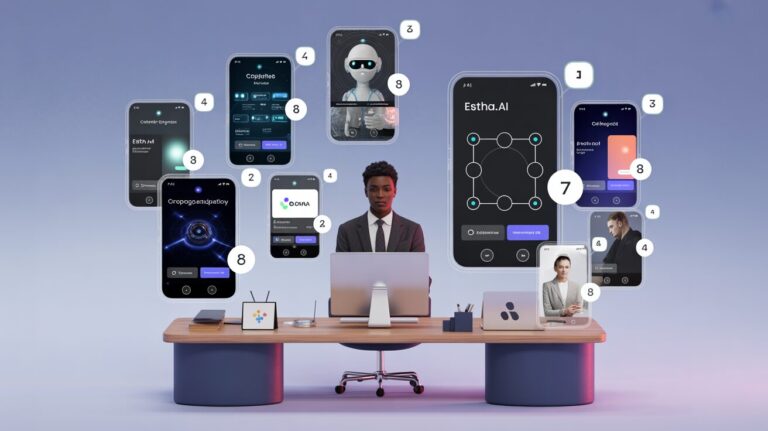Table Of Contents
- Introduction
- Understanding CRM Automation and Its Challenges
- Benefits of AI-Powered CRM Automation
- Why No-Code AI Automation is Changing the Game
- Common CRM Automation Scenarios Using AI
- Implementing AI CRM Automation Without Coding
- Real-World Case Studies: Successful CRM Automation
- Best Practices for CRM Automation with AI Functions
- Conclusion
Customer Relationship Management (CRM) systems are the backbone of modern business operations, housing critical data about prospects, customers, and interactions. However, keeping these systems updated can be labor-intensive and error-prone when done manually. This is where AI automation steps in as a game-changer – but traditionally, implementing AI has required specialized technical skills and programming knowledge.
What if you could automate your CRM updates with powerful AI functions without writing a single line of code? What if sales representatives, customer service teams, and marketing professionals could create custom AI automation tools tailored to their specific CRM workflows without involving IT or development teams?
In this comprehensive guide, we’ll explore how no-code AI platforms are democratizing CRM automation, allowing anyone to build sophisticated AI solutions that streamline data entry, enhance customer insights, and improve team productivity – all without technical expertise. Whether you’re looking to automate lead scoring, data enrichment, follow-up reminders, or personalized communications, you’ll discover practical approaches to implement these solutions using intuitive no-code tools.
Automating CRM Updates with AI Functions
A no-code approach to implementing intelligent CRM automation
CRM Automation Challenges
- Rigid rule-based systems
- Manual data entry causing quality issues
- Technical barriers for business users
- Integration limitations between platforms
Benefits of AI Automation
- Enhanced data quality & completeness
- Predictive insights & recommendations
- Natural language processing capabilities
- Personalization at scale
5-Step Implementation Process
Define Goals
Identify specific CRM processes to automate
Map Data Flows
Identify sources and destination for automation
Build AI App
Select functions and configure I/O through no-code interface
CRM Integration
Connect using APIs or pre-built integrations
Refine & Monitor
Continuously improve based on performance
Key CRM Automation Use Cases
Intelligent Lead Scoring
Analyze behavior patterns to accurately score and prioritize leads
Sentiment Analysis
Automatically detect customer sentiment and trigger appropriate actions
Smart Follow-ups
Determine optimal timing and content for customer communications
Data Enrichment
Automatically fill gaps in customer profiles from multiple sources
Real Results from No-Code CRM Automation
63%
Reduction in lead qualification time
42%
Decrease in sales cycle length
34%
Reduction in customer churn
Create your first AI application in minutes without coding
Understanding CRM Automation and Its Challenges
CRM automation refers to using technology to streamline and automate routine tasks and workflows within your customer relationship management system. Traditional CRM automation has focused on basic tasks like sending welcome emails or assigning leads based on simple rules. However, these conventional approaches often fall short when dealing with complex scenarios that require intelligent decision-making.
The common challenges businesses face with traditional CRM automation include:
- Rigid rule-based systems that can’t adapt to changing customer behaviors or business conditions
- Data quality issues from manual entry that lead to incomplete or inaccurate customer records
- Integration limitations between different tools and platforms in your tech stack
- Technical barriers that prevent business users from creating or modifying automation workflows
- Inability to process unstructured data like emails, calls, or social media interactions
These limitations have traditionally kept advanced CRM automation in the hands of IT departments or required expensive custom development. The result? A significant gap between what businesses need and what they can practically implement with their available resources and expertise.
Benefits of AI-Powered CRM Automation
AI functions take CRM automation to an entirely new level by introducing intelligent capabilities that go far beyond simple if-then rules. When applied to CRM systems, AI can transform how businesses manage customer relationships in several key ways:
Enhanced Data Quality and Completeness – AI can intelligently analyze incoming data from multiple sources, identify patterns, correct inconsistencies, and automatically fill gaps in customer records. This means your team works with more reliable and comprehensive customer information.
Predictive Insights and Recommendations – Rather than just executing predefined workflows, AI can predict customer needs, identify sales opportunities, and recommend next actions based on historical patterns and current behaviors.
Natural Language Processing Capabilities – AI can interpret and extract valuable information from unstructured data like emails, support tickets, or social media comments, automatically updating relevant CRM fields without manual intervention.
Adaptive Learning – Unlike static automation, AI systems improve over time as they process more data, making your CRM automation increasingly effective and accurate.
Personalization at Scale – AI enables hyper-personalized customer communications and experiences based on comprehensive customer profiles and behavioral analysis, all managed and tracked within your CRM.
Why No-Code AI Automation is Changing the Game
The emergence of no-code AI platforms represents a fundamental shift in how businesses can implement advanced CRM automation. These platforms bring several transformative advantages:
Democratization of AI Capabilities – No-code platforms like Estha put the power of AI directly in the hands of business users who understand customer needs best, rather than requiring specialized AI expertise or developer resources.
Rapid Implementation – Instead of lengthy development cycles, no-code platforms enable teams to build and deploy AI-powered CRM automation in days or even hours, allowing businesses to respond quickly to changing market conditions or customer needs.
Customization Without Complexity – These platforms allow for highly customized AI applications that reflect your specific business processes and requirements, without the complexity of traditional development approaches.
Reduced Costs – By eliminating the need for specialized AI developers or data scientists, no-code platforms significantly reduce the cost barriers to implementing AI-powered CRM automation.
Continuous Evolution – Business users can easily update and refine their AI automation as needs change, without depending on technical teams or external consultants.
Common CRM Automation Scenarios Using AI
Let’s explore some of the most valuable ways businesses can apply AI functions to automate CRM processes:
Intelligent Lead Scoring and Prioritization
Traditional lead scoring relies on static rules that may not capture the nuances of potential customer interest. AI-powered lead scoring can analyze multiple factors including behavior patterns, engagement history, and similarity to previously converted leads to assign more accurate scores. The AI can then automatically update lead status fields in your CRM, prioritize high-potential prospects, and even route them to appropriate sales representatives based on their specific characteristics and needs.
Automated Data Enrichment and Cleansing
Maintaining clean, complete CRM data is a persistent challenge for most organizations. AI functions can continuously scan your CRM records, identify missing or outdated information, and automatically enrich profiles by pulling relevant data from multiple sources. For example, when a new lead enters your system with just a name and email address, AI can research and add their company information, role, social media profiles, and potential interests based on their digital footprint – all without manual intervention.
Customer Sentiment Analysis and Response
AI can analyze the sentiment in customer communications across channels (emails, support tickets, chat logs, social mentions) and automatically update appropriate CRM fields to reflect customer satisfaction levels. These updates can trigger appropriate workflows, such as escalating concerns from dissatisfied customers to account managers, or identifying highly satisfied customers for case studies or referral requests.
Smart Follow-up Scheduling and Content
Rather than relying on fixed follow-up schedules, AI can determine the optimal timing and content for customer communications based on their engagement patterns, preferences, and position in the customer journey. The AI can then automatically create follow-up tasks in your CRM with suggested talking points, or even draft personalized email templates tailored to each customer’s specific situation and history.
Implementing AI CRM Automation Without Coding
Now, let’s look at how anyone can implement these AI automation scenarios using a no-code platform like Estha:
1. Define Your Automation Goals
Start by clearly identifying the CRM processes you want to automate and the specific outcomes you want to achieve. Are you looking to improve data completeness? Enhance lead qualification? Personalize customer communications? Having well-defined goals will guide your automation design and help you measure success.
2. Map Your Data Flows
Identify the data sources that will feed into your AI automation (CRM fields, email communications, website interactions, etc.) and determine where the AI’s outputs should be stored or actioned within your CRM. This mapping creates a clear pathway for your automation workflow.
3. Build Your AI Application
Using a no-code AI platform like Estha, you can build your automation application through an intuitive visual interface:
Select AI Functions – Choose from pre-built AI capabilities like sentiment analysis, data extraction, predictive analytics, or natural language processing that match your automation needs.
Configure Inputs and Outputs – Specify what data the AI should analyze and what types of results it should produce. For example, you might input customer emails and output sentiment scores and key topics.
Design the User Experience – If your automation will include human touchpoints, design simple interfaces for team members to review AI suggestions or provide additional inputs.
Test with Real Data – Before full implementation, test your AI application with sample data to ensure it produces accurate and useful results for your CRM updates.
4. Integrate with Your CRM System
Connect your AI application to your CRM using available integration options:
API Connections – Most no-code platforms offer pre-built connections to popular CRM systems like Salesforce, HubSpot, or Microsoft Dynamics.
Webhook Triggers – Set up automated workflows that activate when specific events occur in your CRM.
Scheduled Actions – Configure your AI application to perform regular updates or data enrichment on a predetermined schedule.
5. Monitor Performance and Refine
After implementation, continuously monitor your automation’s performance against your defined goals. Use these insights to refine your AI application, adjusting parameters or adding new capabilities as needed. The beauty of no-code platforms is that business users can make these refinements themselves, creating a cycle of continuous improvement.
Real-World Case Studies: Successful CRM Automation
Case Study: Sales Team Productivity
A mid-sized B2B company was struggling with inconsistent lead qualification and follow-up processes. Using a no-code AI platform, they created an application that automatically analyzed incoming leads, evaluated their fit and readiness to purchase, and updated their CRM with detailed lead profiles and recommended next actions. The application also drafted personalized follow-up emails based on each lead’s specific interests and concerns.
The results were impressive: 63% reduction in lead qualification time, 27% increase in conversion rates, and a 42% decrease in the sales cycle length. Most importantly, the sales team could focus more time on meaningful customer conversations rather than administrative CRM updates.
Case Study: Customer Service Enhancement
A subscription-based service company wanted to improve their ability to identify and address customer satisfaction issues before they led to cancellations. They implemented a no-code AI solution that analyzed customer communications across channels, detected changes in sentiment or emerging issues, and automatically updated the customer’s CRM record with a satisfaction score and highlighted concerns.
The system also triggered appropriate workflows based on these updates – routing accounts with declining satisfaction to customer success managers and flagging specific issues for proactive resolution. This approach resulted in a 34% reduction in churn rate and a 28% improvement in customer satisfaction scores within the first quarter of implementation.
Best Practices for CRM Automation with AI Functions
To maximize the effectiveness of your AI-powered CRM automation, keep these best practices in mind:
Start Small and Expand
Begin with a single, well-defined automation process that addresses a clear pain point in your current CRM workflows. Once you’ve demonstrated success, you can expand to more complex or comprehensive automation scenarios. This incremental approach builds confidence and expertise while delivering immediate value.
Balance Automation with Human Oversight
Even with advanced AI, maintain appropriate human touchpoints in your automation workflows, especially for critical decisions or sensitive customer interactions. Design your system to present AI recommendations for human approval where needed, rather than making all decisions autonomously.
Focus on Business Outcomes, Not Technology
Keep your automation efforts centered on specific business goals and customer needs, rather than implementing AI for its own sake. Every automation should have a clear purpose and measurable impact on your business objectives, whether that’s increased sales, improved customer retention, or operational efficiency.
Train Your Team
Ensure that everyone who interacts with your CRM understands how the AI automation works, what information it provides, and how to effectively use its capabilities. This training is crucial for adoption and for helping team members trust and properly interpret AI-generated updates and recommendations.
Establish a Continuous Improvement Process
Regularly review the performance of your AI automation and gather feedback from users. Use these insights to refine your applications, add new capabilities, or adjust existing parameters. The most successful automation implementations evolve over time to meet changing business needs and incorporate new AI capabilities.
Conclusion
Automating CRM updates with AI functions represents a significant opportunity for businesses of all sizes to enhance customer relationships, improve operational efficiency, and gain competitive advantage. What’s truly revolutionary is that these capabilities are now accessible to everyone through no-code AI platforms, regardless of technical background.
By leveraging intuitive tools like Estha, business professionals can create customized AI applications that automate complex CRM processes, from lead scoring and data enrichment to sentiment analysis and personalized communications. These solutions can be implemented in days rather than months, without specialized development resources, dramatically accelerating your digital transformation journey.
The future of CRM isn’t just automated – it’s intelligently automated in ways that augment human capabilities rather than replace them. By combining the judgment and creativity of your team with the processing power and pattern recognition of AI, you can create CRM workflows that deliver exceptional customer experiences while reducing manual data entry and administrative burden.
As you begin exploring AI-powered CRM automation, remember that the most successful implementations start with clear business objectives, focus on specific use cases, and evolve through continuous refinement. The technology is powerful, but it’s your unique business knowledge and customer understanding that will transform that power into meaningful results.
Ready to automate your CRM updates with AI?
Create your first AI application in minutes without writing a single line of code.



